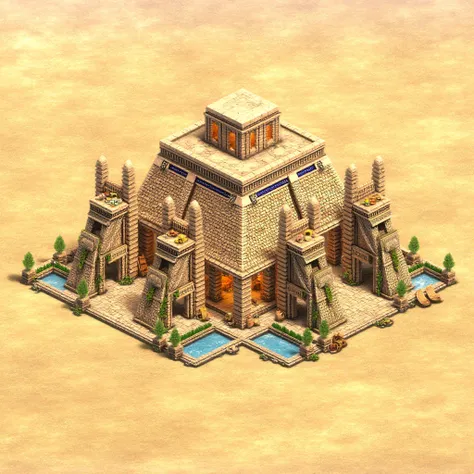In the Imperial Age, the Japanese Town Center becomes an elegant and refined str


Tenho coisas únicas aqui, perfeitas para você.
In the Imperial Age, the Japanese Town Center becomes an elegant and refined structure, reflecting the sophistication and strength of the Japanese empire. The building is constructed primarily from rich, dark wood and stone, with an intricate, multi-tiered pagoda-style roof. The curved, sweeping eaves of the roof are adorned with striking red lines, accentuating the graceful shape and adding a sense of regal distinction to the structure. The roof itself is tiled in dark grey or black, and the vibrant red trim runs along the edges of each tier, creating a bold contrast. At the corners of the roof, intricate carvings of dragons or other mythological creatures are painted red, symbolizing protection and power. The walls of the Town Center are a mix of smooth stone and wood panels, with large, sliding doors at the entrance, framed by red pillars that give the structure a stately and ceremonial look. The windows are tall and narrow, with delicate wooden lattices painted in red, allowing light to filter into the interior while maintaining the building's sense of privacy and strength. Surrounding the Town Center, perfectly manicured gardens with stone pathways, bonsai trees, and ponds add to the serene yet powerful atmosphere. The red lines on the building’s roof and trim signify both the empire’s imperial authority and its deep cultural heritage, making the Town Center a visually striking hub of governance and culture. The combination of dark wood, stone, and bold red accents gives the structure a dignified yet vibrant presence in the heart of the Japanese empire.
Prompts
Copiar prompts
In the Imperial Age, the Japanese Town Center becomes an elegant and refined structure, reflecting the sophistication and strength of the Japanese empire. The building is constructed primarily from rich, dark wood and stone, with an intricate, multi-tiered pagoda-style roof. The curved, sweeping eaves of the roof are adorned with striking red lines, accentuating the graceful shape and adding a sense of regal distinction to the structure.
The roof itself is tiled in dark grey or black, and the vibrant red trim runs along the edges of each tier, creating a bold contrast. At the corners of the roof, intricate carvings of dragons or other mythological creatures are painted red, symbolizing protection and power. The walls of the Town Center are a mix of smooth stone and wood panels, with large, sliding doors at the entrance, framed by red pillars that give the structure a stately and ceremonial look.
The windows are tall and narrow, with delicate wooden lattices painted in red, allowing light to filter into the interior while maintaining the building's sense of privacy and strength. Surrounding the Town Center, perfectly manicured gardens with stone pathways, bonsai trees, and ponds add to the serene yet powerful atmosphere.
The red lines on the building’s roof and trim signify both the empire’s imperial authority and its deep cultural heritage, making the Town Center a visually striking hub of governance and culture. The combination of dark wood, stone, and bold red accents gives the structure a dignified yet vibrant presence in the heart of the Japanese empire.
INFO
Checkpoint & LoRA
comentário(s)
4
0
0









